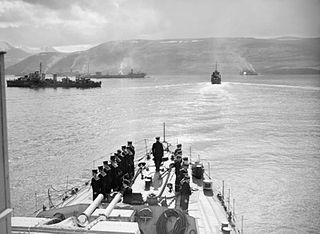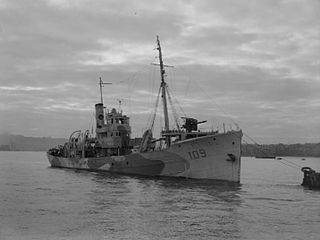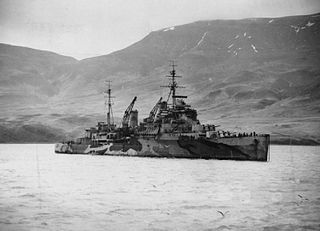
PQ 17 was the code name for an Allied Arctic convoy during the Second World War. On 27 June 1942, the ships sailed from Hvalfjörður, Iceland, for the port of Arkhangelsk in the Soviet Union. The convoy was located by German forces on 1 July, after which it was shadowed continuously and attacked. The First Sea Lord Admiral Dudley Pound, acting on information that German surface units, including the German battleship Tirpitz, were moving to intercept, ordered the covering force built around the Allied battleships HMS Duke of York and the USS Washington away from the convoy and told the convoy to scatter. Because of vacillation by Oberkommando der Wehrmacht, the Tirpitz raid never materialised. The convoy was the first large joint Anglo-American naval operation under British command; in Churchill's view this encouraged a more careful approach to fleet movements.
HMT Cambridgeshire (FY142) was a British Second World War anti-submarine trawler of the British Royal Navy, named after Cambridgeshire, an English county.

HMT Lord Hailsham (FY109) was a Royal Navy vessel that saw service in the Second World War. The ship was named after Douglas Hogg, 1st Viscount Hailsham.

HMS Malcolm was one of eight Admiralty-type destroyer leaders built for the Royal Navy during World War I. She was the first of only two Royal Navy ships to carry the name Malcolm, although HMS Valkyrie was originally planned to bear the name. She was one of two Admiralty-type leaders to miss the First World War but saw service in, and survived, the Second World War. Her pennant number was changed from D19 to I19 in May 1940. She was broken up in 1945.

PQ 13 was a British Arctic convoy that delivered war supplies from the Western Allies to the USSR during World War II. The convoy was subject to attack by German air, U-boat and surface forces and suffered the loss of five ships, plus one escort vessel. Fifteen ships arrived safely.
MV Atheltemplar was a motor tanker built by Lithgows, Port Glasgow. She was launched on 15 April 1930, registered in Liverpool and operated by the United Molasses Co Ltd of London. She was transferred to Athel Lines on 1 January 1940.
HMS La Malouine was a Flower-class corvette of the Royal Navy, serving during the Second World War. Originally ordered by the French Navy under the same name, following the fall of France, the ship was seized by the United Kingdom and commissioned into the Royal Navy in 1940. The corvette remained in service until being broken up in 1947.

HMS Jason was a Halcyon-class minesweeper. She was named after the hero in Greek mythology and was the sixteenth Royal Navy ship to carry the name Jason. She was laid down on 12 December 1936, launched on 6 October 1937, and was completed on 9 June 1938. She survived the Second World War and was sold in 1946 to become a cargo ship. She was eventually broken up in 1950. Her pennant number was originally N99, but was changed to J99 in May 1940.

HMS Opportune was an O-class destroyer of the Royal Navy. She was ordered from John I. Thornycroft & Company, Woolston on 3 September 1939 for the 1st Emergency Flotilla. She was commissioned on 14 August 1942. She was the second Royal Navy ship borne Opportune.
HMT Bedfordshire (FY141) was an armed naval trawler in the service of the Royal Naval Patrol Service during World War II. Transferred to the East Coast of the United States to assist the United States Navy with anti-submarine patrols, she was staffed by a British and Canadian crew. Bedfordshire was sunk by the German submarine U-558 on 11 May 1942 off the coast of Ocracoke Island in the Outer Banks of North Carolina, with the loss of all hands.

HMS Attack was an Acheron-class destroyer built in 1911, which served during the First World War and was sunk in 1917 in the Mediterranean by a German U-boat. She was the third ship of the name to serve in the Royal Navy.
SS Gallois was one of seven merchant vessels which became stranded and then wrecked on Haisbro Sands of the Norfolk coast on 6 August 1941 during the Second World War. The SS Gallois had been part of a convoy with the designation Convoy FS 559.
The Torpedo Alley, or Torpedo Junction, off North Carolina, is one of the graveyards of the Atlantic Ocean, named for the high number of attacks on Allied shipping by German U-boats in World War II. Almost 400 ships were sunk, mostly during the Second Happy Time in 1942, and over 5,000 people were killed, many of whom were civilians and merchant marines. Torpedo Alley encompassed the area surrounding the Outer Banks, including Cape Lookout and Cape Hatteras.
HG 84 was an Allied convoy of the HG series during World War II.

HMS Salvia (K97) was a Flower-class corvette of the Royal Navy. She was ordered on the eve of the Second World War and entered service in September 1940. She rescued many survivors from the prison ship SS Shuntien when it was sunk on 23 December 1941. A few hours later, on Christmas Eve 1941, Salvia too was torpedoed. The corvette sank with all hands, and all of the survivors that she had rescued from Shuntien were also lost.

HMS Vanessa (D29) was a V-class destroyer of the British Royal Navy that was in service during World War I and World War II.

HMS Whitehall, pennant number D94, later I94, was a Modified W-class destroyer of the British Royal Navy that saw service in the Second World War.

Convoy QP 11 was an Arctic Convoy of World War II, made up of merchant ships returning from the Soviet Union to Britain after delivering their cargo to the Soviet Union. The convoy consisted of 13 merchant ships, escorted by 18 warships. The convoy was attacked by German destroyers and submarines, suffering the loss of one merchant ship as well as the light cruiser HMS Edinburgh. The German forces lost the destroyer Z7 Hermann Schoemann.

SS Ashkhabad was a merchant ship of the Soviet Union sunk in 1942. She had been built as a British merchant ship in 1917 in Glasgow, Scotland as War Hostage. Over the next three decades she passed through a number of owners and had several different names; Milazzo (1919–1924), Aldersgate (1924–1925), Mistley Hall (1925–1934), Kutais (1934–1935), Dneprostroi (1935–1938) and finally Ashkhabad from 1938 to 1942. Originally designed as a freighter, she was at several points converted to a tanker to carry fuel oil. At the time of her loss the four hundred foot tanker was owned by the Soviet Union's Sovtorgflot organisation. She was torpedoed on 29 April 1942, and then sunk as a hazard to navigation on 3 May 1942. The wreck is now a popular dive site.

HMS Sharpshooter was a Halcyon-class minesweeper of the British Royal Navy. Built at Devonport Dockyard, Sharpshooter was completed in 1937. She served through the Second World War, acting both in her designed role as minesweeper and as a convoy escort, escorting several Arctic convoys. She took part in the evacuation from Dunkirk in 1940, and sank the German submarine U-655 in 1942.












